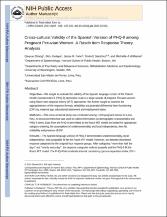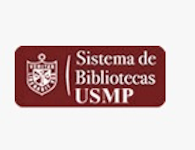Mostrar el registro sencillo del ítem
Cross-cultural validity of the spanish version of PHQ-9 among pregnant peruvian women: a rasch item response theory analysis
| dc.contributor.author | Zhong, Qiuyue | |
| dc.contributor.author | Gelaye, Bizu | |
| dc.contributor.author | Fann, Jesse R. | |
| dc.contributor.author | Sanchez, Sixto E. | |
| dc.contributor.author | Williams, Michelle A. | |
| dc.date.accessioned | 2020-07-08T16:06:05Z | |
| dc.date.available | 2020-07-08T16:06:05Z | |
| dc.date.issued | 2014-04 | |
| dc.identifier.citation | Zhong Q., Gelaye B., Fann JR., Sanchez SE., Williams MA. Cross-cultural validity of the spanish version of PHQ-9 among pregnant peruvian women: a rsch item response theory analysis. J Affect Disord. 2014; 158: 148-153. | es_PE |
| dc.identifier.uri | https://hdl.handle.net/20.500.12727/6305 | |
| dc.description.abstract | Objective We sought to evaluate the validity of the Spanish language version of the patient health questionnaire-9 (PHQ-9) depression scale in a large sample of pregnant Peruvian women using Rasch item response theory (IRT) approaches. We further sought to examine the appropriateness of the response formats, reliability and potential differential item functioning (DIF) by maternal age, educational attainment and employment status. Methods This cross-sectional study was conducted among 1520 pregnant women in Lima, Peru. A structured interview was used to collect information on demographic characteristics and PHQ-9 items. Data from the PHQ-9 were fitted to the Rasch IRT model and tested for appropriate category ordering, the assumptions of unidimensionality and local independence, item fit, reliability and presence of DIF. Results The Spanish language version of PHQ-9 demonstrated unidimensionality, local independence, and acceptable fit for the Rasch IRT model. However, we detected disordered response categories for the original four response categories. After collapsing “more than half the days” and “nearly every day”, the response categories ordered properly and the PHQ-9 fit the Rasch IRT model. The PHQ-9 had moderate internal consistency (person separation index, PSI=0.72). Additionally, the items of PHQ-9 were free of DIF with regard to age, educational attainment, and employment status. Conclusions The Spanish language version of the PHQ-9 was shown to have item properties of an effective screening instrument. Collapsing rating scale categories and reconstructing three-point Likert scale for all items improved the fit of the instrument. Future studies are warranted to establish new cutoff scores and criterion validity of the three-point Likert scale response options for the Spanish language version of the PHQ-9. | es_PE |
| dc.format.extent | pp. 148-153 | es_PE |
| dc.language.iso | eng | es_PE |
| dc.publisher | Elsevier B.V. | es_PE |
| dc.relation.ispartof | urn:issn:0165-0327 | |
| dc.relation.ispartofseries | Journal of Affective Disorders;vol. 158 | |
| dc.relation.uri | https://www.ncbi.nlm.nih.gov/pmc/articles/PMC4004697/ | es_PE |
| dc.relation.uri | https://doi.org/10.1016/j.jad.2014.02.012 | es_PE |
| dc.rights | info:eu-repo/semantics/openAccess | es_PE |
| dc.rights.uri | https://creativecommons.org/licenses/by-nc-nd/4.0/ | es_PE |
| dc.source | Repositorio Académico USMP | es_PE |
| dc.source | Universidad San Martín de Porres - USMP | es_PE |
| dc.subject | Transculturación | es_PE |
| dc.subject | Mujeres embarazadas | es_PE |
| dc.subject | Cuestionario de salud del paciente | es_PE |
| dc.title | Cross-cultural validity of the spanish version of PHQ-9 among pregnant peruvian women: a rasch item response theory analysis | es_PE |
| dc.type | info:eu-repo/semantics/article | es_PE |
| thesis.degree.name | Medicina Humana | es_PE |
| thesis.degree.grantor | Universidad de San Martín de Porres. Facultad de Medicina Humana | es_PE |
| thesis.degree.discipline | Medicina | es_PE |
| dc.subject.ocde | https://purl.org/pe-repo/ocde/ford#3.02.00 | es_PE |
Ficheros en el ítem
Este ítem aparece en la(s) siguiente(s) colección(es)
-
Artículos [274]








